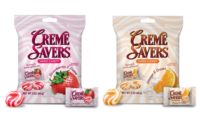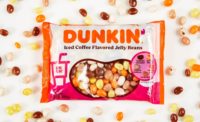Outside of southeast Wisconsin, the name Candy Raisins would inspire some confusion.
The burnt-orange, Jujube-esque treats don’t look like raisins, save for a signature wrinkle on top. And they certainly don’t taste like raisins, with the flavor prompting a different description from each taster.
But for much of metropolitan Milwaukee — including John Barker, founder and owner of Lake Country Candies in Delafield, Wis. — Candy Raisins mean one thing: nostalgia.
Barker, who also owns Arcon Manufacturing, a custom snap ring business, remembers picking them up from convenience stores on the way to a friend’s house and on golf outings as a child.
“It’s like having any kind of food you really love — a certain apple pie, a certain chocolate chip cookie, a recipe someone had — it’s like that,” Barker says.
“It was just a good candy for me,” he continued. “It wasn’t like chocolate. It wasn’t like Skittles.”
A love for Candy Raisins stayed with Barker into adulthood. He even kept a Tupperware container of them in his nightstand. But in May 2009, after breaking his leg while playing softball, he was in desperate need of Candy Raisins.
Mostly immobile, Barker asked his then-wife to pick up a bag of the treats. She couldn’t find them anywhere. A quick Internet search revealed that Revere, Mass.-based New England Confectionery Corp. (NECCO), parent company of Stark Candy Co., Candy Raisins’ former manufacturer, suspended production of the regional confection in mid-2008.
Barker was not pleased, to say the least. And neither were other Candy Raisin fans. Petitions to bring the treats back into production began to circulate.
“How (could) they stop making them? That’s unheard of,” Barker says. “In my world, if there’s demand there should be supply.”
NECCO apparently disagreed. Barker estimated the company annually produced up to 400,000 pounds of Candy Raisins in its heyday — likely a pittance compared to some of NECCO’s more well-known brands.
Barker waited for another die-hard Candy Raisin lover to relaunch the sweet in its exact form, but he had no such luck. After a couple years, Barker, already a manufacturer, decided to take matters into his own hands and began investigating the process.
While traveling home one day, Barker saw activity inside the old Stark NECCO plant in Pewaukee, Wis., about 10 miles east of Delafield. He stopped by in hopes someone was preparing to produce Candy Raisins.
A local businessman had taken over the factory building, but he had no plans to use it for candy making. However, while at the plant, Barker ran into a reminiscing former Stark employee who helped connect him with Steve Niere, a 35-year Stark veteran and a Candy Raisin expert.
Barker asked Niere to help him relaunch the treat, but Niere was leary. Several similar requests had come Niere’s way, and he was afraid he’d be let go once the future manufacturer had what they needed.
But, over a meeting at a Chili’s, Niere became convinced Barker could pull it off. Because of his knowledge and first-hand experience with the process, Barker hired Niere to be Lake Country Candies’ plant manager.
“There are a lot of little details that need to be right, which a guy like Steve has right up in here,” Barker said, pointing to his head, “where other people don’t know because it’s not what they’re accustomed to doing.”
The next step was securing equipment. In a 9,200-sq.-ft. space on the east side of Barker’s manufacturing facility, they set up a fully-rebuilt 1986 Makat mogul line, which they purchased in 2013. After six months and $400,000 in transportation and rebuilding, the line was ready for production in July 2014.
Barker also set up a kitchen with two 100-gallon stainless steel kettles manufactured by Pick Heaters, a West Bend, Wis. company. The kitchen and mogul line are connected by lines that pump over a heated mixture of sugar, corn syrup, color and flavoring. After the mixture is deposited in 420-piece starch moulds, it is cured for 48 hours in a 120-degree hot room and given a coat of carnauba wax.
“It works really well,” Barker says. “We put together a nice facility that does exactly what we want it to do.”
However, capturing the signature Candy Raisins texture and flavor wouldn’t be so easy. And they had to recreate it perfectly to please longtime fans and compete with another manufacturer that had started making a similar product.
“We wanted to bring it back in its exact form, exact texture, shape, size, color, everything,” Barker says. “We needed to hit 100 percent.”
Barker turned to chemists and food scientists at the University of Wisconsin-Madison to help clinch the texture, but what they came up with was “too sticky and too gooey,” he says. Barker suggested reducing the amount of corn syrup and raising the amount of sugar.
It worked. “We nailed it,” he says. “That was it.”
To get the flavoring, Barker reached out to the firm that sold the flavor formula to NECCO, but without an identification number, Barker couldn’t get it. Through chance, however, Barker’s dentist knew a former employee of the flavor company who pulled some strings to get Barker the number.
Barker then had all the pieces in place. Production began in 2014, much to the joy of Candy Raisin fans. While driving around in a truck with Lake Country Candies’ logo and the Candy Raisins moniker, people would stop Niere, he said.
“They’d come up along side, give you the thumbs up or ‘Are you kidding me? Is this the real Candy Raisins?’” he says. “I’d give them (a bag), and they’d be all smiling. It’s crazy.”
Others wrote letters, thanking Lake Country Candies for resurrecting the dormant brand.
“People were just so sad that they lost their Candy Raisins,” Niere says. “Thanks to John, we brought it back and made Milwaukee happy.”
Barker wants to make more than metro Milwaukee happy, however. In 2017, he hopes to expand the reach of Candy Raisins, but some modifications are required to appeal to a national audience.
Instead of the “raisin” shape, Barker will put the flavor into a coin with Lake Country’s sun logo and brighten the orange color. Lake Country also makes the coin in other flavors, including Strawberry Black Licorice and Salted Caramel.
“It’s a better marketing strategy to capture people who have never had (Candy Raisins) before,” Barker says.
Even if outsiders don’t see the beauty in Candy Raisins, Barker and Niere take satisfaction from their fans’ reactions.
“You really get a lot of fulfillment out of the fact that people have the knowledge and the history behind that, know what it was all about,” Barker says.

































